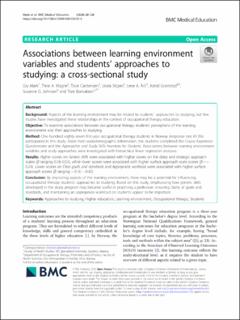| dc.contributor.author | Mørk, Gry | |
| dc.contributor.author | Magne, Trine A | |
| dc.contributor.author | Carstensen, Tove | |
| dc.contributor.author | Stigen, Linda | |
| dc.contributor.author | Åsli, Lene Angel | |
| dc.contributor.author | Gramstad, Astrid | |
| dc.contributor.author | Johnson, Susanne Grødem | |
| dc.contributor.author | Bonsaksen, Tore | |
| dc.date.accessioned | 2020-04-22T07:44:59Z | |
| dc.date.available | 2020-04-22T07:44:59Z | |
| dc.date.created | 2020-04-03T21:49:18Z | |
| dc.date.issued | 2020 | |
| dc.identifier.citation | BMC Medical Education. 2020, 20 (120), 1-8 | en_US |
| dc.identifier.issn | 1472-6920 | |
| dc.identifier.uri | https://hdl.handle.net/11250/2651986 | |
| dc.description.abstract | Background: Aspects of the learning environment may be related to students` approaches to studying, but few studies have investigated these relationships in the context of occupational therapy education.
Objective: To examine associations between occupational therapy students’ perceptions of the learning environment and their approaches to studying.
Method: One hundred eighty-seven first-year occupational therapy students in Norway (response rate 61.3%) participated in this study. Aside from sociodemographic information, the students completed the Course Experience Questionnaire and the Approaches and Study Skills Inventory for Students. Associations between learning environment variables and study approaches were investigated with hierarchical linear regression analyses.
Results: Higher scores on Generic skills were associated with higher scores on the deep and strategic approach scales (β ranging 0.18–0.51), while lower scores were associated with higher surface approach scale scores (β = − 0.24). Lower scores on Clear goals and standards and Appropriate workload were associated with higher surface approach scores (β ranging − 0.16 - -0.42).
Conclusion: By improving aspects of the learning environment, there may be a potential for influencing occupational therapy students’ approaches to studying. Based on this study, emphasizing how generic skills developed in the study program may become useful in practising a profession, ensuring clarity of goals and standards, and maintaining an appropriate workload on students appear to be important | en_US |
| dc.language.iso | eng | en_US |
| dc.publisher | BioMed Central | en_US |
| dc.subject | approaches to studying | en_US |
| dc.subject | higher education | en_US |
| dc.subject | learning environment | en_US |
| dc.subject | occupational therapy students | en_US |
| dc.subject | ergoterapistudenter | en_US |
| dc.subject | læringsmiljø | en_US |
| dc.subject | høyere utdanning | en_US |
| dc.title | Associations between learning environment variables and students’ approaches to studying: a cross-sectional study | en_US |
| dc.type | Peer reviewed | en_US |
| dc.type | Journal article | en_US |
| dc.description.version | publishedVersion | en_US |
| dc.rights.holder | Open Access | en_US |
| dc.source.pagenumber | 1-8 | en_US |
| dc.source.volume | 20 | en_US |
| dc.source.journal | BMC Medical Education | en_US |
| dc.source.issue | 120 | en_US |
| dc.identifier.doi | https://doi.org/10.1186/s12909-020-02033-4 | |
| dc.identifier.cristin | 1805252 | |
| cristin.ispublished | false | |
| cristin.fulltext | original | |
| cristin.qualitycode | 1 | |
